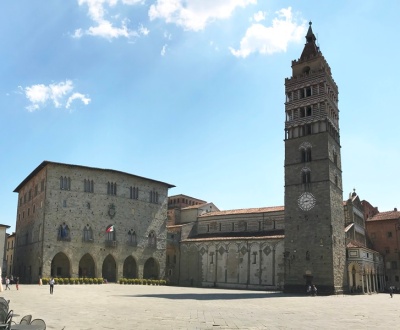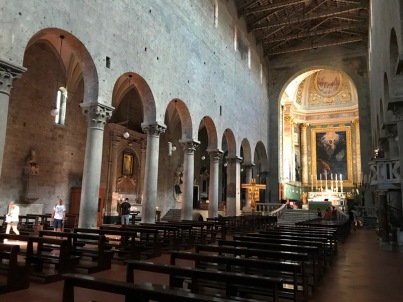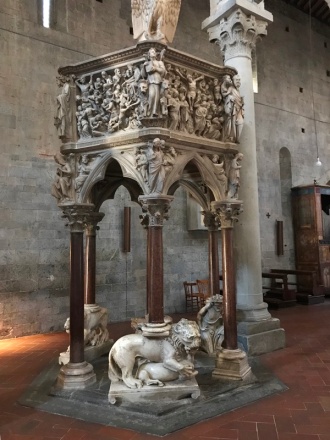It is not easy to have an important role in the Italian tourism when you are in the same land of Florence, Siena, Pisa or San Gimignano.
But Pistoia, not by chance named “Italian Capital of Culture 2017“, is a town rich in works of art, culture and history. It is a town of small dimensions that can easily be visited in a day, without too many worries of mind and without having to elbow in the crowd, as happens in the most noble neighboring cities.
The city tour
The tour of Pistoia can only start from the nice and central Piazza Duomo (photo 1). It is a very large square overlooked by the main monuments of the town, the Cathedral of St. Zeno, the Bell tower, the Municipal Palace, the Baptistery and the Court, buildings that make the place truly magical and evocative.

In photo 1 you can admire, in particular, the Municipal Palace (on the left) and the Bell tower (on the right).
The Municipal Palace, originally from the 13th century, is a very nice building with medieval features dating back to 1200, with five arches and a beautiful civic museum present inside. Of great interest is the bridge, on the right looking at the building, which connects the Palace with the nearby Cathedral, an architectural device that allowed the coeval city authorities to quickly reach the interior of the Church.
The Bell Tower is 66-meter-high and is a splendid example of Pisan Gothic architecture that flanks the left side of the Cathedral. It is characterized by three different stylistic orders, more austere in the lower part and gradually more elaborate in the upper part where a double mullioned window at half height stands out and the two-colored gothic loggia in the highest part.
In front of the Municipal Palace you find the Palazzo Pretorio, the seat of the Court. During office opening hours it is possible to launch inside the gaze where on the ground floor there are some beautiful nineteenth century decorations.
Next to the Bell Tower there is the Cathedral (photo 2), dedicated to St. Zeno.

Outside of the Cathedral, of ancient foundation, it is possible to admire the three orders of loggias and a fourteenth-century portico, with terracotta decorations by Andrea della Robbia (photo 3).

The interior of the Cathedral (photo 4) is influenced by the stylistic nature of the various reconstructions, with the three naves with a simple and austere style and the apse of Baroque style. In the right nave, the beautiful silver dossal, a precious work of jewelery made between 1287 and 1456.

In front of the Cathedral, the beautiful octagonal Baptistery (photo 5) that recalls the stylistic aspect of the nearby Church. Designed by Andrea Pisano, it presents on the outside with bicrome bands, white and green, like many other buildings in the town.

A little more than 200 meters from Piazza Duomo, along Via Filippo Pacini, we arrive to the beautiful Church of St. Bartolomeo in Pantano (photo 6), a thirteenth-century building with a beautiful façade with bichrome arches in Pisan style.

The inside of the church (photo 7), with an austere appearance, has three naves on columns, with an apse that preserves a 13th century fresco depicting a Christ Pantocrator.

Proceeding for another 150 meters along Via Filippo Pacini you reach the Ospedale del Ceppo (photo 8), a medioeval hospital built between the thirteenth and fourteenth centuries, adorned with a beautiful terracotta frieze of the Della Robbia school. It was the seat of the city hospital until 2013, today it is the location of a medical museum and of the health administrative offices.

Continuing along Via delle Pappe you reach, in little more than five minutes of walking, the Parish Church of St. Andrea (photo 9), one of the most significant examples of Pisan Gothic architecture. It is a sacred building of great historical tradition (lay along the Via Francigena), the outer part has a striking white-green facade of the twelfth century with five arches. Of great particularity is the portal surmounted by a marble decoration that describes the evangelical episode of the Epiphany, a very rare representation in sacred architecture.

In the inside the most important aspect is certainly the splendid thirteenth-century pulpit by Giovanni Pisano (photo 10) who, according to the observers of the time, on this occasion “knew how to overcome his father in wisdom“. It is one of the absolute masterpieces in the Italian art scene.
The structure of the pulpit is inspired by that of the pulpit of the Cathedral of Pisa, the work of his father Nicola. It is hexagonal in shape, resting on seven columns, six on the top and one central. Of the six columns placed at the top, two are supported by lions, one by a curved telamon, while the central column rests on three figures. The pulpit presents a very crowded representation with stories from the life of Christ. One of the most noteworthy panels is the one depicting the massacre of the innocents, in a scene of great and swirling movement.

Retracing your steps and passing Piazza Duomo you reach the Church of St. John Fuorcivitas (photo 11). Originally from the 12th century, the façade is incomplete. The interior has a single nave and preserves a magnificent holy water font by Giovanni Pisano and a pulpit by Fra’ Guglielmo da Pisa.

Where to park
One of the most complicated aspects when visiting a city is to find a parking space not too far from the city center.
I tell you what I did. I set the navigator on Piazza San Lorenzo where there is a fairly large parking (of course fee). The historic center is no more than a 10-minute walk away.
Where to eat
Pistoia, like all Tuscany, is quite expensive, so it is not easy to find restaurants where to eat at reasonable prices.
I can suggest the “Winery No. 4“, a small place where they prepare various delicacies such as excellent croutons, with fixed price menu, a good solution for a quick lunch without having to spend a fortune. My full review on Tripadvisor can be found here.


Concordo in pieno. È una città che ha sorpreso anche me. Ha solo la sfortuna di trovarsi in una zona d’Italia fin troppo ricca di città belle e blasonate.
Grazie per il commento 😊
"Mi piace"Piace a 1 persona
Un articolo molto interessante su una piccola ma splendida città della Toscana che, a mio avviso, merita di essere visitata con attenzione, alla stregua di altre (forse) più blasonate città della stessa regione, a cui Pistoia non ha davvero nulla da invidiare 🙂
"Mi piace"Piace a 1 persona